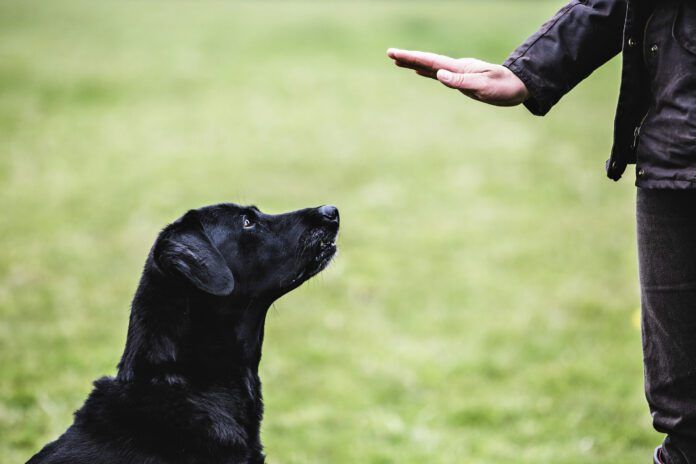Training a deaf dog requires patience and consistency, just as training a dog who can hear does. While replacing the verbal “sit” with a hand cue may seem odd to you, it’s normal for your dog. He’s been watching you all along. According to a 2018 study published in Animals, dogs naturally communicate with their bodies, as well as visual, tactile, acoustic, and olfactory signals.
Always have yummy treats ready for your training sessions, so you can capture and reward desired behaviors whenever they occur. Let’s start!
Teach Attention
All dogs need to be able to pay attention to their humans, but with deaf dogs, it’s critical. Because the dog can’t hear, training a deaf dog requires that he learn to look at you. Start with your dog on a six-foot leash.
This will take patience, but your dog will look at you. When he does, reinforce with a treat. Do this a half-dozen to a dozen times, and then end the session. You can repeat the session later. After he gets the idea that looking at you is the desired behavior, just give the attention cue and reward him when he looks at you.
You can train a “pay attention to me” cue, like pointing to your face, but if simply you treat each time he looks at you – consistently! – he will happily and frequently look at you, hoping it pays off with a yummy treat.
If He Ignores You
If your dog looks away too much, don’t worry. Just remember to reward him when he looks at you. To increase his attention, you can:
- Make vibrations. As you approach your dog, he may feel the floor vibrating and turn to look at you. If not, you may stomp your foot or hand on the floor to get his attention. Treat when he looks at you.
- Use a flashlight. Turning a flashlight on and off a few times should get your dog’s attention inside any time or outside at night. Do the light flashes inside near him first, so that you can give him a treat immediately after he looks at you. You want him to understand that’s the desired behavior. You can even use a porch light turned on and off to get attention at night. Caution using light sources though: Some dogs may develop OCD and compulsively chase the lights, especially lasers.
- Gently touch his shoulder or on his back above his tail. Before doing this, you need to condition him that this is a positive action so that you don’t startle him.
- Use a vibrating collar. This can be used to get your dog’s attention. The point is to communicate, not punish. Some dogs may be sensitive to the vibrations and become stressed. If so, use a different method to get his attention. Never use a shock collar, which is always aversive.
Hand Signals
You can use traditional hand obedience-competition signals: adapt some from American Sign Language, or make up your own. Dogs are experts at reading body language. Whatever you select, it’s crucial that you and everyone working with your deaf dog are precisely consistent in the signal used, including which hand is used. Each hand signal must be distinctive from the others.
When using hand signals, you can speak the word for the behavior cue. Even though the dog can’t hear it, you will probably be more natural if you simultaneously say the cue as you give the signal.
Use lure-reward training when teaching a cue using a hand signal. The dog will naturally follow the motion of the lure. “Sit” is a basic behavior to start with. Have a yummy treat in your hand and hold it just above your dog’s nose. Slowly move it toward the back of his head, then lift your elbow up toward a 90-degree angle. As soon as your dog’s posterior touches the ground in a sit, give him his reward treat.
In another training session, you can teach him to lie down on cue. Make a sweeping motion with a treat in front of his nose down to the ground when he’s sitting, luring him down. Treat and reward when his elbows come into contact with the ground.
Frankly, hand signals help any dog – with or without hearing – pay more attention to you. Even if your dog still has his hearing, many lose it as they age. And, just as with us, background noise can get in the way of the dog hearing a verbal cue. Plus – there may be times you can’t (or don’t want to) speak – like when you’re on the phone with a client.
Mark the Behavior
Since your dog can’t hear the traditional “good job” reward marker such as the click of a clicker or a verbal “Yes!” you need a different reward marker. This can be a thumbs-up, the action of clapping your hands, or even nodding your head a few times. And smile! Your dog will notice. Use your reward marker signal after he performs the desired behavior cue, then immediately provide him with his reward treat. Remember that every time you mark a behavior you must treat or provide some other high-value reinforcer.
If at any time your dog is reactive, aggressive, or you’re not making progress, get professional help before proceeding. Take your deaf dog to the veterinarian to be sure there aren’t any physical issues. You can also contact the International Association of Animal Behavior Consultants or the American College of Veterinary Behaviorists to find a behavior specialist in your area. If you need help with the training itself, you can contact the Pet Professional Guild or the Certification Council for Professional Dog Trainers.






